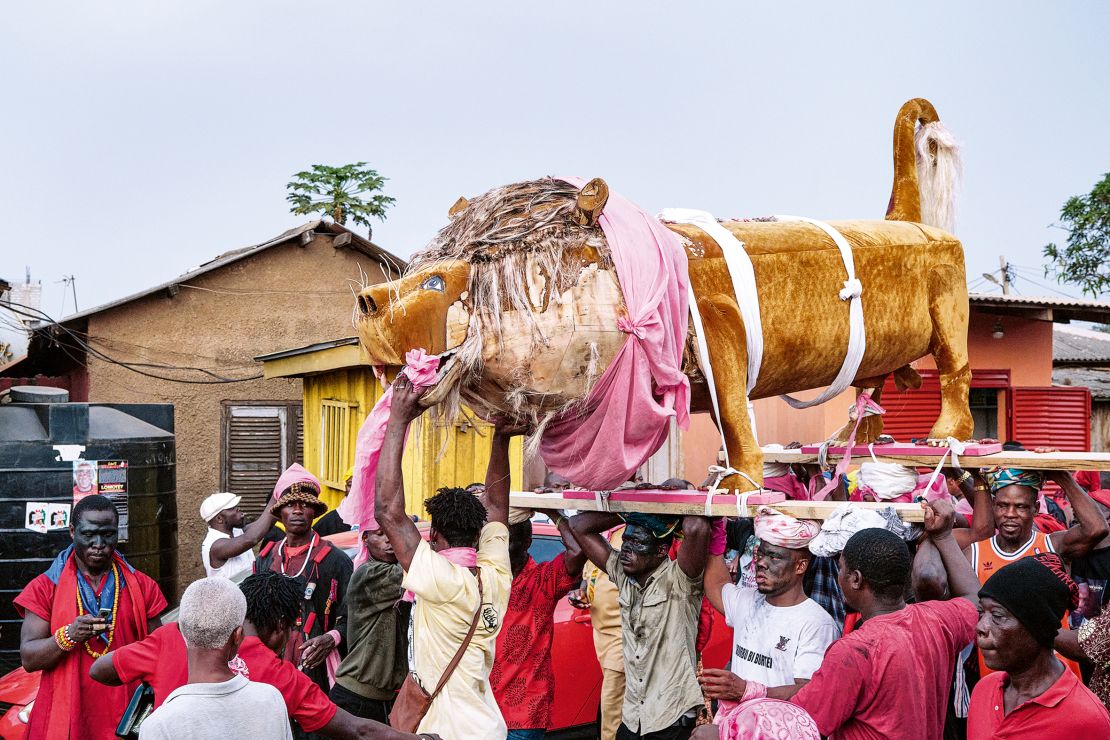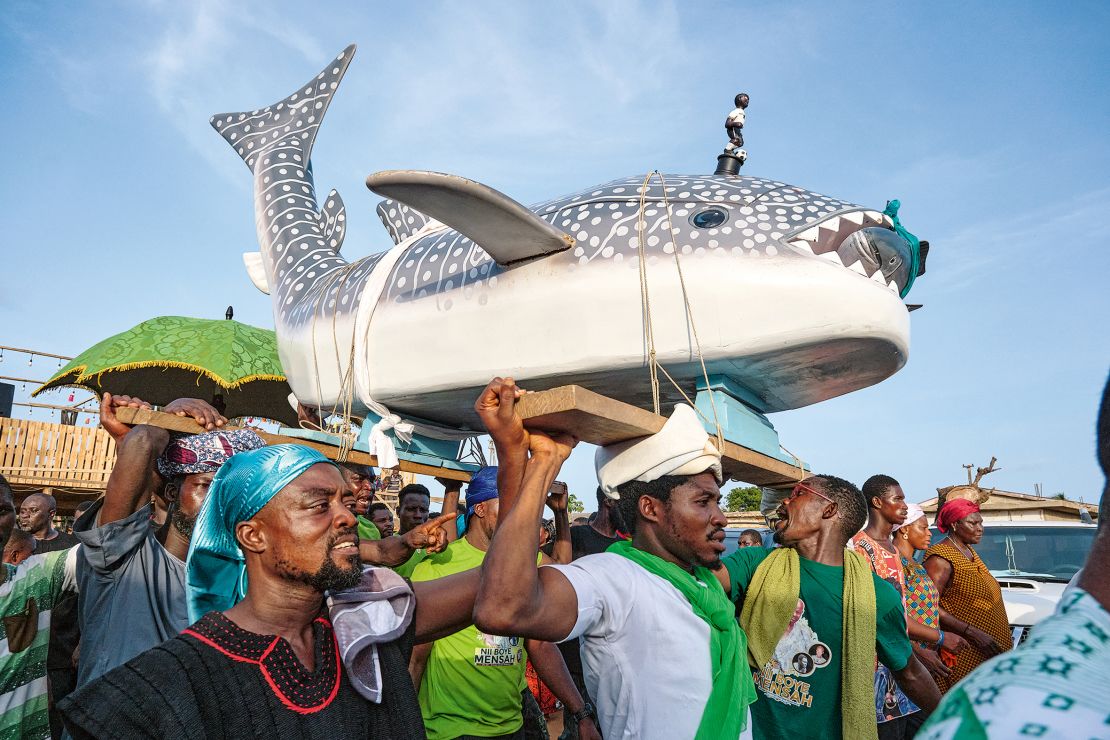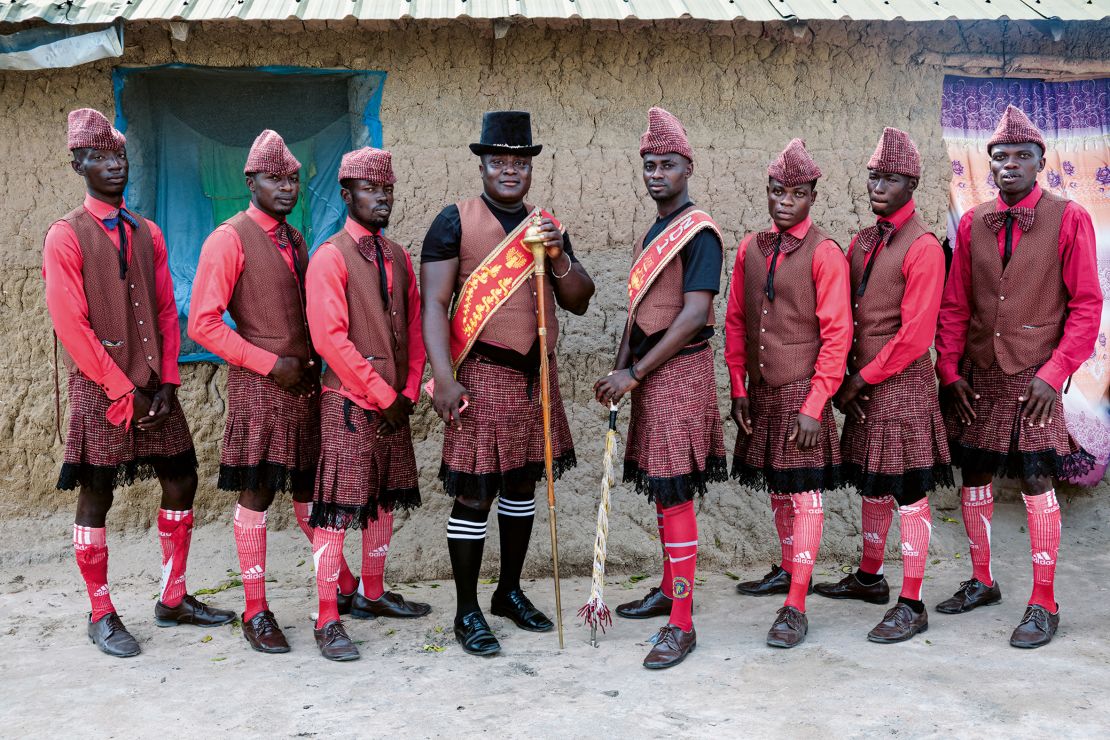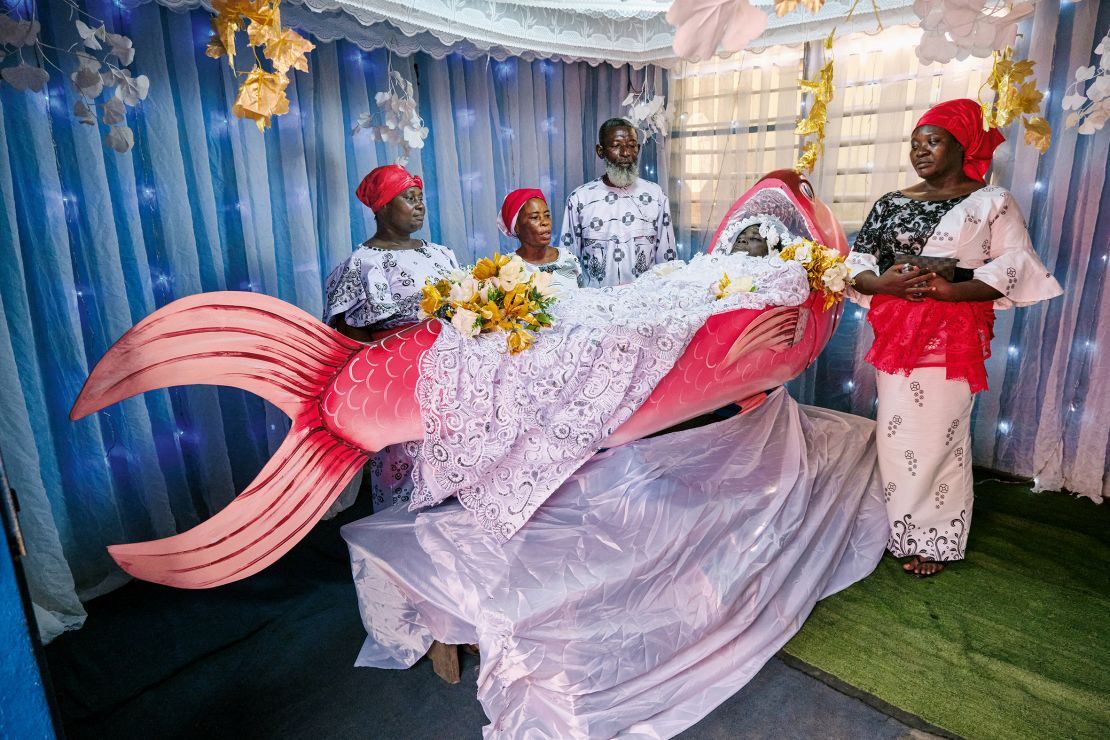CNN
—
It was a funeral two years in the making. The deceased had laid in a morgue in Greater Accra, Ghana, biding his time in icy torpor as plans were made for his final journey. There was financing to be sourced, a coffin to be built, a procession to be organized, rituals to follow, much of it shrouded in secrecy. Everything had to be perfect. After all, the man, Nii Agbetekor, had been the supreme traditional military leader of the town of Nungua.
An event of this scale had not been mounted for more than 20 years, according to Swiss academic Regula Tschumi, who was there to document it all. When the day arrived, in November 2024, not everything went to plan, she recalled. Nii Agbetekor’s lion-shaped coffin caught fire, burning most of its pink mane. A ribbon was found to cover the worst of the damage and the procession continued. Otherwise, the funeral went well. The five military chiefs of the Amanfa clan, all very much living, followed the deceased in elaborate seats known as palanquins — a turtle, a chili pepper, a rooster and a mudfish, and in a palm, the dead chief’s successor — while men in traditional uniform and other villagers thronged the streets.
Tschumi, an anthropologist, had heard of the event months in advance. What she didn’t know until she arrived was that her own research had helped plan the day. Not all rites are easily remembered, and the organizers had pored over a book she had written that covered the last time a supreme leader had passed. Using that information, and photos she had sourced, they were able to renew their traditions.

It’s not the first time Tschumi has found herself in this position. Her 20-plus years of documenting the unique funeral traditions of the Ga people of southeast Ghana has resulted in a PhD on the subject, multiple academic volumes, and now an eye-opening photography book, “Buried in Style: Artistic Coffins and Funerary Culture in Ghana.”
Tschumi’s book contains photographs from 2004 to 2024, taken mostly of the Ga people of Greater Accra, but also the Fante, Ewe and Asante peoples of the neighboring Central, Eastern and Volta Regions. She collates them into sections covering Christian and traditional funerals, the rise of coffin dancers in Ghana, the tradition of “laying out,” and an index of bespoke figurative coffins made by local artisans.

These coffins emerged in the mid-20th century, and were originally derived from the decorative traditional palanquins, said Tschumi.
In recent years they have captured the internet’s imagination thanks to their outlandish designs and literal intent. For example, a footballer who dreamed of moving to the United States was buried in football boot-shaped coffin, painted in the stars and stripes of the US flag, in 2022. Or a midwife buried inside a casket in the form of a laboring woman, in 2011. Or a traditional priest buried inside a giant blue teapot in 2009 — a reference to the one he would use in rituals.
Interestingly, it’s not the deceased but their family who decides on the design, Tschumi told CNN in a video call. “The family come to the (coffin maker)” she said. “Sometimes the artist has an idea, sometimes the family, sometimes they bring a photograph.”
Coffins typically take five to 10 days to create, and until recently carpenters worked entirely by hand, she explained. “They are not very expensive” by Western standards, Tschumi said. “That’s why (coffin makers) like to do business abroad,” she added; “to have a coffin bought by a museum (or) gallery is bigger business.”
Documenting the caskets is hard work. She’ll often have to stake out workshops for hours, as once coffins are finished, they’re quickly whisked away by relatives. That said, it’s nowhere near as hard as gaining access to some of the funerals.
“The Ga, they are not very open to foreigners,” said Tschumi, who has spent years earning the trust of village dignitaries, priests and persons of repute within the funeral trade.
There are good reasons for the Ga to be guarded. As the book notes, many traditional funeral practices were suppressed during the British colonial era, driving some already secretive rites further underground.
One was the practice of burying the dead under the floors of houses, Tschumi said, so that the spirit of the deceased could easily find its way back to the family home. When the colonial government forced the Ga to use cemeteries instead, it jeopardized this spiritual journey. However, the anthropologist has been told that the practice still continues in some areas.
Other elements of traditional funerals have also eluded her camera so far. “For chiefs and priests, we still don’t know where they are buried,” Tschumi said, explaining that chiefs are often buried at night away from prying eyes, with funerals conducted later, and performed with an empty coffin or palanquin.
But for the most part, the academic has achieved an incredible degree of access. A key figure in her story is Benjamin Aidoo, the originator of the now-famous “coffin dancers,” who has helped open doors for her since they first met in the early 2010s.

Aidoo entered the funeral business as an apprentice, working Fridays and Saturdays while still in high school to support his family, he told CNN on the phone.
“Marching solemly, you’d see people crying, people mourning, and it got to me,” he said. “I asked myself: Why do we mourn? We need to celebrate the dead.”
His realization would find an outlet years later as an undertaker running his own company, Nana Otafrija Pallbearing and Waiting Services.
One day, around 2012, he was waiting while carrying a coffin. Traditional drums played in the background. “I decided to start moving left, right, left, right. People stopped crying, then started to cheer us, started to throw money at it,” he recalled. “I said, ‘Wow, if I can do this and people stop crying, why don’t I get professional?’”
He began drilling his pallbearers in choreography, purchasing matching costumes and traveling the country for funerals. Business exploded pre-Covid, Aidoo said, when videos of his dancers went viral online and he employed approximately 100 people (the number is smaller now, he notes).
Today, routines and outfits are often bespoke, and Aidoo’s coffin dancers highly sought after. The company has also spurred on imitators, not all of whom are as skilled or well trained, notes Tschumi. Recently, pallbearers for one such company dropped a coffin during a routine and the academic said Aidoo feared it could hurt his business.
“As a professional, if a coffin goes down it’s the end of your career,” he said. “It was not my people, but it was very bad.”
Tschumi calls Aidoo “one of my best friends,” and that friendship has allowed her to witness parts of the funeral trade conducted strictly behind closed doors.
The tradition of displaying the deceased ahead of a funeral is hardly unique, but certain Ghanaian communities elevate the practice. In some of Tschumi’s most revealing photographs she documents the ornate and extravagant vigils known as “laying out.”
“Laying out” usually occurs the night before the funeral, and involves family and friends congregating in large, draped tents to pay their respects to and interact with the deceased. “Everything needs to look like reality,” said Aidoo. “You need to open their eyes to make sure everything is clear for people to see … You need to stuff their cheeks with cotton with surgical tools.”
The body is often posed in a seated position or standing to meet guests, and is dressed and accessorized in ways pointing to the life they lived. Throughout the night the deceased is sometimes “re-posed” by undertakers out of sight from mourners.
“Most undertakers won’t do that — they don’t know how,” said Tschumi, though Aidoo is one who can. “They are stiff, so it needs strength. They work sometimes in three or four people on the body.”

The most elaborate laying out Tschumi has witnessed was a priestess in the Central Region in 2017. The priestess started seated in her palanquin, which hung from the ceiling, before being repositioned “three or four” times and her outfit changed. In her last change, she was covered in white paste to protect her from evil and arranged like the day she was installed as a priestess, in a room that was a recreation of her shrine.
Laying out is not just for dignitaries, and not just solemn occasions. Tschumi’s book documents ceremonies for a fishmonger and a roadworker. The academic recounted a vigil in 2022 where the deceased, beer in hand, manned his own lit barbecue. “We put sausages on it. It was like a party, and he was there among the people,” she recalled.
On her trips, she has been intrigued to see new traditions emerge in other parts of the country. Tschumi recalled learning that her 2011 book “Concealed Art History, Transformation and Use of the Figurative Palanquins and Coffins of the Ga in Ghana” was shown by coffin makers to chiefs in the Central Region, west of where the Ga live in Greater Accra. The chiefs, who had not previously used palanquins, then began requesting their own, she said. “It’s interesting to see how the work of a researcher can influence the tradition in a place.”
“Buried in Style: Artistic Coffins and Funerary Culture in Ghana,” published by Kehrer Verlag, is available in bookshops now.
This story has been updated to clarify details of Nii Agbetekor’s coffin







